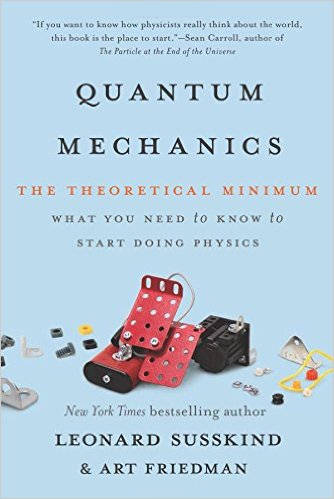| Quantum Mechanics: The Theoretical Minimum |
|
Author: Leonard Susskind, Art Friedman There are lots of people who want to know about quantum mechanics just because it is interesting. Is this a book for them? This is the second volume in the planned series "The Theoretical Minimum", which isn't really a good title because it suggests that some how the math is left out (see our review of Vol 1). In both this and the first volume this isn't the case. What is left out is the nitpicky proofs that you would have to go though in any "proper" academic course. This book doesn't duck the math, it simply presents it as part of the narrative. What this means is that if you are math phobic you aren't going to get very far with this book. Indeed if you are a complete lay person and haven't done any physics or math then similarly you aren't going to get much from this book. This is not a book for the general reader.
The ideal reader for this book is someone who has either done a conventional course in QM or is currently doing one. The standard approach to QM is to work through some of the experiments - Young's Slits etc - and then present the Schrodinger equation and spend the rest of the time solving it and explaining what a Hilbert space is all about. At the end of the course you can do the sums and perhaps answer the exam questions, but you probably don't "get" QM in any depth. If you want to "get" QM in much deeper depth then this book is for you. Instead of starting with a discussion of all of the experiments that prove that reality isn't particle and it isn't wave, the book takes a different approach. It starts from the idea of a simple quantum system - a spin-1 particle and then works its way through the classical and quantum versions of the theory that applies to it. This approach de-emphasizes the Schrodinger equation and emphasizes the operator approach. This means you get the bones of QM without having to worry about integrals or normalizable functions. Put another way, you start off with a finite-dimensional Hilbert space. Chapter 3 introduces the basics of QM - operators, matrices, eigenvalues and eigenstates, Hermitian operators, orthogonal basis and so on. All this is done using the bra and ket notation, which makes things seem easy and logical because of the way the bras and kets just fit together. This is the right way to do things because starting from the wave function and trying to convert to using bra and ket notation later on isn't easy and it can be very confusing. From this point the book moves its way through time development and Unitary operators and the role of the Hamiltonian. We also learn about uncertainty in the most general possible way and discover the Heisenberg uncertainty principle as a special case of the general.
For many readers the highlight of the entire book will be entanglement, covered in Chapters 6 and 7. This is the mysterious property of QM that Einstein called "spooky action at a distance". While many physicists manage to understand entanglement, many of them don't see what troubled Einstein. These chapters explains exactly what is so odd about entanglement in terms of the difference setups needed to simulate an entangled system. This is a really great read if you are trying to come to terms with quantum computation. The only disappointment is that just as you feel that you can, at last perhaps, understand the Bell inequality, Chapter 7 comes to an end without discussing it. Similarly the whole topic of quantum computers is ignored. The final three chapters are about working back from the finite- dimensional operator description of QM to the more traditional materials of an introductory QM course - the wave function, Schrodinger's equation, position and momentum representations, the Fourier transform between position and momentum states and finally the harmonic oscillator, which prepares the ground for quantum field theory. In fact the whole book provides a much better approach to QM if your ultimate aim is to learn QFT.
What is missing? The big omission is the solution of the hydrogen atom. You don't get to see that the Schrodinger equation and the Hamiltonian for the hydrogen atom give you a near complete explanation of the observed spectra and the start of theoretical chemistry. However, this is only supposed to be a lightweight introduction to QM and the solution of the hydrogen atom is very math heavy. All the way through the book there are non-technical discussions of what is going on. These are usually missing from lesser courses on the subject. The comments on wave function collapse and measurement as entanglement are worth the cost of the book on their own and will keep you awake at night. Highly recommended as long as you can cope with the math. Related Reviews
To keep up with our coverage of books for programmers, follow @bookwatchiprog on Twitter or subscribe to I Programmer's Books RSS feed for each day's new addition to Book Watch and for new reviews.
|
|||
| Last Updated ( Thursday, 18 January 2018 ) |

